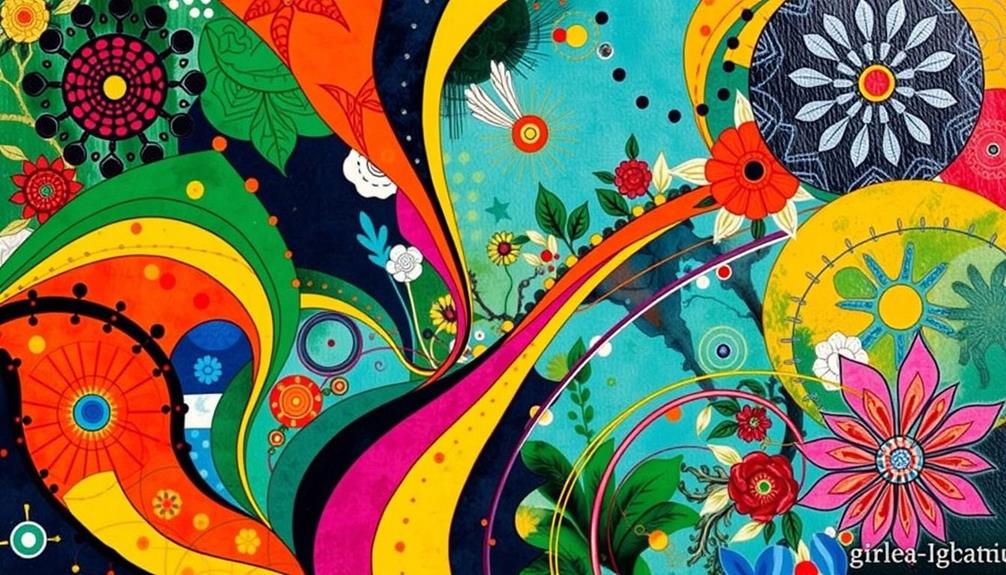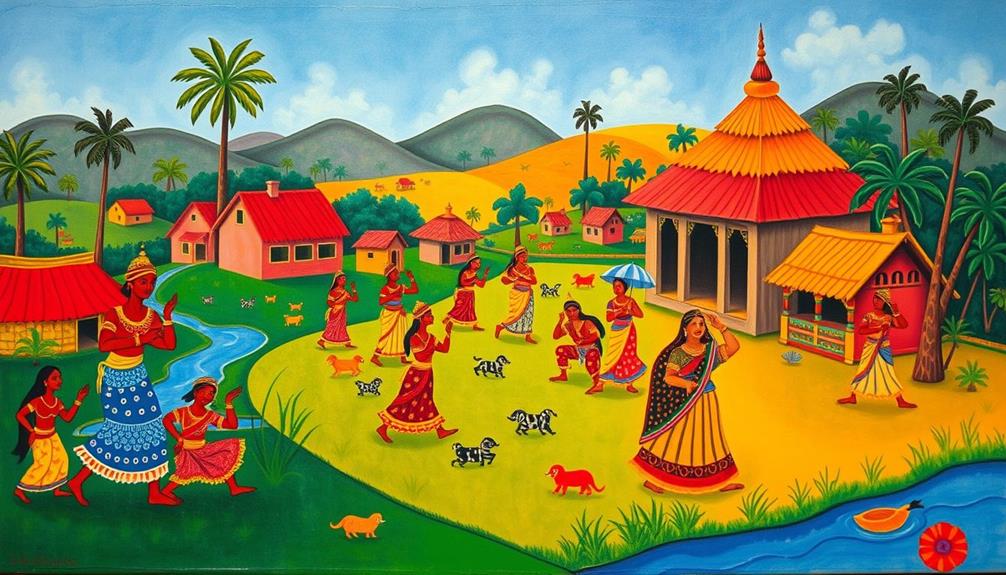The evolution of abstract art in India has been a vibrant journey, starting in the mid-20th century. You'll see a fascinating blend of Western modernism and indigenous traditions shaping the movement. Artists like F.N. Souza and S.H. Raza emerged from the Progressive Artists Group, pushing boundaries with bold colors and geometric forms. This art form doesn't just showcase aesthetics; it reflects deeper emotional and spiritual connections. As Indian artists innovate, they continue to influence global movements, enriching the cultural tapestry. If you keep exploring, you'll uncover even more layers of this dynamic artistic evolution.
Key Takeaways
- Indian abstract art emerged in the mid-20th century, influenced by both Western modernism and indigenous artistic traditions.
- The Progressive Artists Group, founded in 1947, aimed to modernize Indian art and included key figures like F.N. Souza and S.H. Raza.
- Color and emotion are central to Indian abstraction, with artists using vibrant palettes to evoke spiritual and personal experiences.
- Geometric shapes and forms characterize the artwork, blending traditional aesthetics with contemporary expressions and inviting individual interpretation.
- Indian abstract art has gained global recognition, impacting international movements and showcasing artists in prominent exhibitions and art fairs.
Historical Context of Indian Abstraction
Indian abstraction, shaped by a blend of Western modernism and indigenous traditions, emerged prominently in the mid-20th century. This movement gained traction with the formation of the Progressive Artists Group in 1947, which sought to liberate art from traditional academic styles. Key figures like F.N. Souza, S.H. Raza, and M.F. Husain played significant roles in integrating these influences into their works, reflecting the evolving cultural landscape of post-independence India.
As artists explored new mediums and forms, they began to reveal beauty in imperfections and stains, challenging traditional notions of beauty in art the creativity behind unconventional art forms.
As the country navigated its newfound identity, artists embraced abstract expressionism, seeking a new visual language that resonated with their experiences and aspirations. By the 1960s and 1970s, the exploration of cubist and semi-cubist styles became prominent, marking a notable shift in the Indian art scene.
VS Gaitonde emerged as a pivotal figure, actively promoting abstract art through exhibitions that encouraged younger artists to push boundaries. His participation in international showcases, including at the Museum of Modern Art in New York, helped elevate Indian abstraction on the global stage.
This historical context set the foundation for a vibrant artistic dialogue, allowing Indian abstraction to flourish and evolve in unique ways.
Characteristics of Indian Abstract Art

When you explore Indian abstract art, you'll notice how color and emotion play an essential role in conveying the artist's inner experiences.
This art form often reflects deep emotional connections, much like the way true love quotes capture profound sentiments.
Geometric shapes and forms often dominate the canvas, creating a dynamic interplay that invites you to interpret the work in your own way.
This unique blend of vibrant hues and structured elements makes Indian abstract art an enthralling experience.
Color and Emotion
Abstract art in India captivates with its vibrant colors and emotional depth, inviting viewers to explore a domain where form and feeling intertwine. Indian abstract art goes beyond recognizable objects, focusing instead on color and emotion.
Artists like V. S. Gaitonde and S. H. Raza masterfully utilize vibrant color palettes and bold strokes to convey their inner thoughts and spiritual experiences. The emotional connection established through these colors can be likened to the effects of essential oils for relaxation, where both aim to create a serene and introspective atmosphere.
In their works, color becomes a powerful means of expression, evoking a range of emotions that resonate with both local and global audiences. The integration of traditional Indian aesthetics enriches these pieces, allowing for a dialogue between historical narratives and contemporary emotional expressions.
You'll notice how the use of color isn't merely decorative; it's fundamental to the artwork's emotional impact. The bold strokes and dynamic compositions create an atmosphere that invites personal reflection.
While geometric shapes often play a role, it's the emotional resonance of the colors that truly captivates. This focus on color and emotion in Indian abstract art offers a unique lens through which to experience the rich tapestry of cultural and spiritual narratives embedded in the artwork.
Geometric Shapes and Forms
Color and emotion form a strong foundation in Indian abstract art, but geometric shapes and forms add another layer of complexity. These geometric shapes serve as a departure from recognizable objects, focusing instead on visual structure and composition. Artists like Suman Dey and Sibaprasad Karchaudhuri skillfully incorporate geometric elements, creating vibrant structures that embody emotional depth and philosophical concepts.
Understanding safe foods for pets, such as those found in dog nutrition, can enhance the connection between art and life experiences, including how we care for our beloved animals.
In Indian abstract art, bold strokes and well-defined geometric patterns reflect inner thoughts and spiritual experiences, seamlessly blending modernity with traditional aesthetics. This emphasis on geometric forms not only contributes to a unique visual language but also connects the art to its cultural heritage and indigenous traditions.
Each piece becomes a dialogue between past and present, illustrating how artists navigate the tension between historical narratives and contemporary expressions.
Ultimately, the use of geometric shapes in Indian abstract art distinguishes it from Western movements, allowing for a rich exploration of meaning and context. By embracing these forms, you engage with a visual journey that resonates deeply, inviting you to reflect on the intricate relationship between art, culture, and emotion.
Key Figures in Indian Abstract Art

When you explore the key figures in Indian abstract art, you'll uncover how influential artists like F.N. Souza and S.H. Raza blended cultural heritage with innovative techniques.
Their contributions, much like the evolving dynamics seen in celebrity relationships, not only shaped the movement but also inspired countless others to push the boundaries of abstraction.
You'll see how each artist's unique style enriched the evolution of modern Indian art.
Influential Artists' Contributions
In the domain of Indian abstract art, several key figures have emerged, each making distinct contributions that have shaped the movement. The Progressive Artists Group, formed in 1947, included influential artists like M.F. Husain, who brilliantly merged Western modernism with indigenous traditions, paving the way for Indian Abstract Paintings.
This fusion not only enriched the artistic landscape but also resonated with contemporary audiences, showcasing the importance of AI transformations in healthcare in understanding cultural narratives. V. S. Gaitonde, another prominent member, is known for his mature abstract style, earning accolades like the Padma Shri, which inspired younger generations of artists to explore their creativity.
Nasreen Mohamedi brought a minimalist approach to the scene, integrating abstract elements drawn from Indian music and Islamic architecture, showcasing the diverse influences on Indian abstraction.
Tyeb Mehta introduced vibrant forms that redefined traditional motifs, establishing a unique visual language within the genre. Additionally, artists like Ram Kumar and G. R. Santosh contributed markedly to the evolution of Indian abstract art by fusing their cultural heritage with modern artistic expressions.
Together, these artists not only advanced the field but also enriched the landscape of Indian abstract art, ensuring its relevance and dynamism in contemporary discourse.
Cultural Heritage Influence
Cultural heritage greatly influences the evolution of Indian abstract art, as key figures weave traditional motifs into their modern interpretations. Indian abstract artists like F.N. Souza and S.H. Raza have played pivotal roles in blending cultural elements with modern abstraction. V.S. Gaitonde's unique approach emphasizes emotional depth and spiritual experiences, creating a visual language that resonates globally.
In this context, the following table highlights the contributions of notable artists:
| Artist | Contribution |
|---|---|
| F.N. Souza | Merged traditional Indian motifs with modern themes. |
| S.H. Raza | Explored spirituality through abstract landscapes. |
| V.S. Gaitonde | Integrated Western modernism with Indian philosophy. |
| K.G. Subramanyan | Combined contemporary art with folk traditions. |
| Tyeb Mehta | Reflected India's heritage while engaging with global art trends. |
These artists not only showcase the richness of cultural heritage but also pave the way for contemporary art that speaks to both personal and collective narratives. Their work exemplifies how Indian abstract art thrives on the interplay between tradition and modernity.
Evolution of Techniques
The evolution of techniques in Indian abstract art reflects the innovative spirit of key figures who've redefined artistic expression. The Progressive Artists Group, founded in 1947, championed abstract techniques that led to modern abstraction, with artists like M.F. Husain, S.H. Raza, and Tyeb Mehta at the forefront. Their work illustrates how the integration of diverse influences can enhance creative output, similar to how AI enhances accuracy in medical diagnoses.
V.S. Gaitonde's meditative use of color and form beautifully merges traditional Indian aesthetics with Western modernism, creating profound visual experiences.
Nasreen Mohamedi's minimalist approach stands out for its delicate lines and geometric shapes, influenced by Islamic architecture and Indian music. This choice highlights the diversity within abstraction.
Meanwhile, Suman Dey, through self-taught techniques, emphasizes vibrant color and emotional expression, weaving a unique personal narrative that invites viewers to explore dreams and memories.
In contemporary practice, artists like Subodh Gupta and Bharti Kher have pushed boundaries by integrating mixed media into their works. They skillfully combine traditional motifs with modern techniques, crafting layered narratives that resonate with both heritage and innovation.
Together, these artists showcase a dynamic evolution that enriches the landscape of Indian abstract art.
Influences Shaping Indian Abstract Artists

Throughout the evolution of Indian abstract art, various influences have melded to create a distinctive visual language. Indian abstract artists drew heavily from Western modernists like Klee, Rothko, and Pollock, which shaped their approach to abstraction and experimentation with form and color. This fusion of styles allowed you to explore new dimensions in your work.
Additionally, traditional art forms, including tribal, folk, and tantric motifs, provided a foundation for cultural references that evolved into modern abstract forms. These cultural motifs serve as crucial elements in your artistic expression, bridging the past with contemporary practice. The Progressive Artists Group, established in 1947, played an essential role in this transformation, with key figures like F.N. Souza and S.H. Raza pioneering innovative approaches.
Moreover, the psychological impact of zodiac signs on self-perception can also be observed in how artists embody their creative personas, influencing their unique expressions and styles certain zodiac signs associated with higher charisma levels.
However, you've faced the ongoing tension between traditional artistry and modern abstract exploration. Creating pure abstraction within a decorative art milieu presents challenges, compelling you to navigate these contrasting influences.
Ultimately, the influences shaping Indian abstract artists have led to a rich dialogue between tradition and modernity, resulting in a unique visual language that resonates across different contexts.
Impact on Global Art Movements

Indian abstract art's evolution hasn't only enriched its own landscape but also profoundly impacted global art movements. Artists like V.S. Gaitonde and S.H. Raza have showcased their work in global exhibitions, blending traditional Indian aesthetics with modern artistic expressions.
This innovative fusion gained momentum through the efforts of the Progressive Artists Group, which formed in 1947 and played a significant role in merging Indian abstraction with Western modernism. The growing interest in personality assessments has also influenced how artists perceive and express their individuality, adding layers of meaning to their work.
As you explore the domain of contemporary art movements, you'll notice how Indian abstraction has inspired artists worldwide, encouraging a dialogue that highlights the dynamic interplay between cultural heritage and modernity.
This exchange has elevated Indian abstract art's profile in prestigious international art fairs and auctions, showcasing its global relevance and attracting attention from collectors and curators alike.
The unique blend of traditional Indian elements and abstract forms has captivated audiences across the globe, influencing trends in abstraction and fostering cultural exchange within the international art community.
Indian abstract art has become an essential thread in the fabric of global art, enriching the narrative of contemporary artistic expression while celebrating its rich heritage.
Future Directions in Indian Abstract Art

Exploring new avenues, Indian abstract art is set to flourish as artists blend traditional influences with contemporary techniques. Modern Indian artists are keen on pushing boundaries, maintaining a strong connection to their cultural heritage while experimenting with mixed media and unconventional methods.
This experimentation fosters innovative representations of abstract themes, allowing for fresh perspectives and creativity. As seen in other art forms, like modern farmhouse decor trends, the harmony of old and new can inspire creativity and drive artistic expression.
Emerging talents are essential in this evolution, as they bring unique voices and ideas into the mix. Institutions like the Emami Art Gallery play a significant role, promoting both established and emerging artists, and providing platforms for diverse artistic expressions.
These spaces encourage ongoing dialogues about the balance between tradition and modernity, which will certainly shape the future trajectory of Indian abstract art.
As you engage with this evolving landscape, you'll notice how Indian abstract art's global presence continues to expand. The integration of technology in art, while not the focus here, helps facilitate connections with international audiences and collectors.
This dynamic environment promises to keep Indian abstract art relevant and influential, paving the way for future generations to explore and innovate within this vibrant field.
Technology's Role in Art Access

The rise of technology has revolutionized how you access and engage with abstract art. Online art galleries have made it easier than ever to explore a diverse range of styles and Indian artists from the comfort of your home. Platforms like Indian Art Ideas showcase over 10,000 paintings across various mediums, allowing you to find unique pieces that resonate with your personal taste.
This shift in the art-buying landscape means art patrons can buy paintings without the traditional barriers of location or time constraints. You can browse, discover, and purchase abstract art at your own pace, making the accessibility of abstract art far greater than before.
Moreover, technology's role in enhancing quality assurance has created a trustworthy environment for transactions, ensuring you feel confident in your purchases. Digital platforms don't just facilitate buying; they foster a deeper engagement with Indian abstract works, broadening appreciation and understanding on a global scale.
In this interconnected world, you're not only a buyer but a participant in a vibrant artistic dialogue, connecting with a wider community of art lovers and creators.
Frequently Asked Questions
What Is the History of Abstract Art in India?
Abstract art in India began in the mid-20th century, influenced by Western modernism. You'll find key figures like F.N. Souza and S.H. Raza blending traditional motifs with contemporary styles, creating a unique artistic identity.
How Did Abstract Art Evolve?
You'd think abstract art just popped up overnight, but it evolved through experimentation, cultural fusion, and the daring spirit of artists. They broke free from tradition, creating a vibrant world where color and emotion reign supreme.
What Is the Revolution of Abstract Art?
The revolution of abstract art signifies a shift from traditional forms to a focus on color, shape, and emotion. You'll find artists embracing freedom, breaking boundaries, and creating unique expressions that challenge conventional aesthetics.
What Is Art in Indian Context?
Art in the Indian context reflects your cultural heritage, blending historical narratives with contemporary expressions. You'll find traditional motifs and modern interpretations, creating a vibrant dialogue that celebrates identity while embracing innovation and global influences.
Conclusion
As you explore the evolution of abstract art in India, you'll discover how history, culture, and innovation intertwine. You'll see how key figures have shaped this vibrant landscape, how influences have expanded horizons, and how future directions promise even more creativity. Embrace the journey of Indian abstraction, celebrate its unique characteristics, and recognize its impact on the global stage. With technology bridging gaps and enhancing access, the future of Indian abstract art is bright and full of possibilities.









